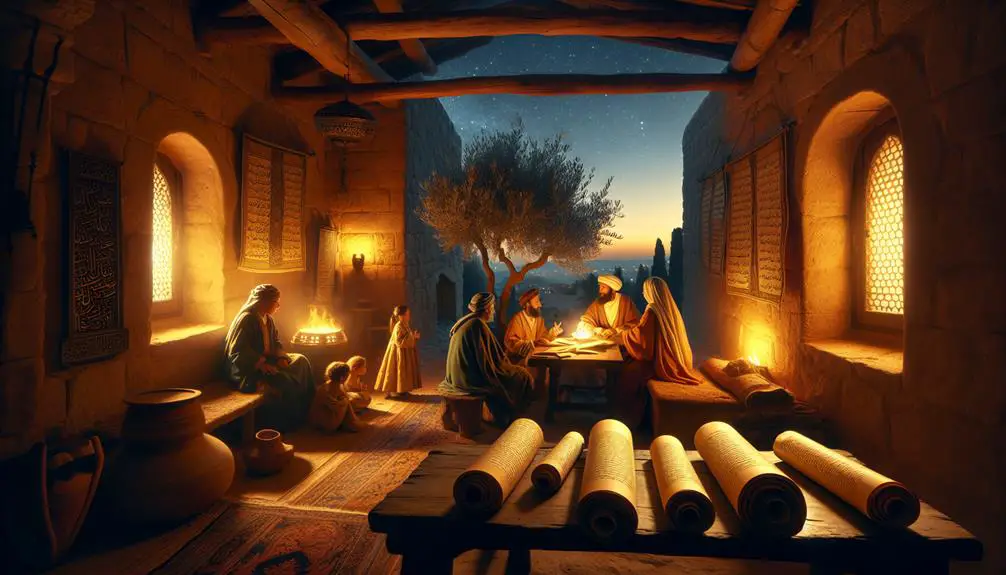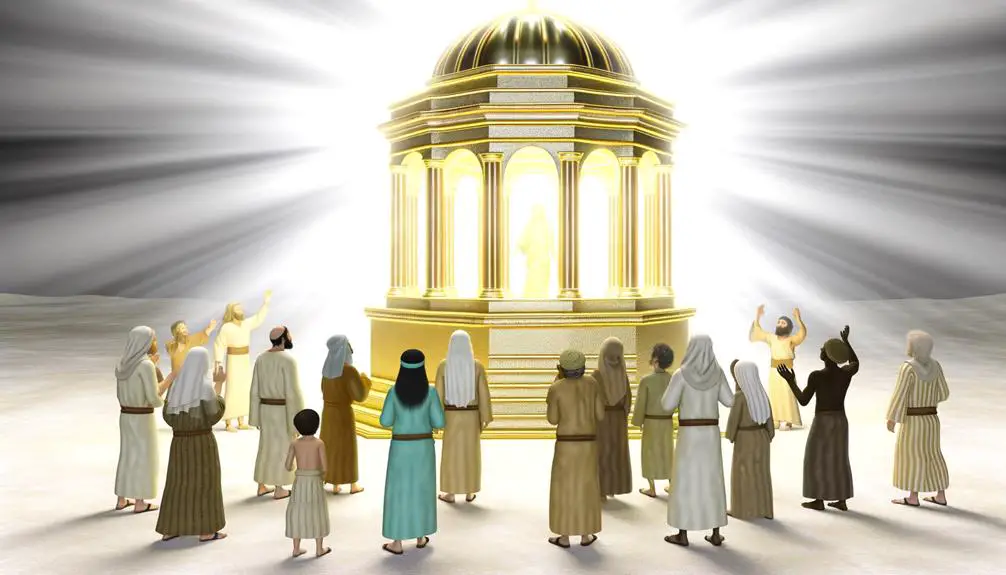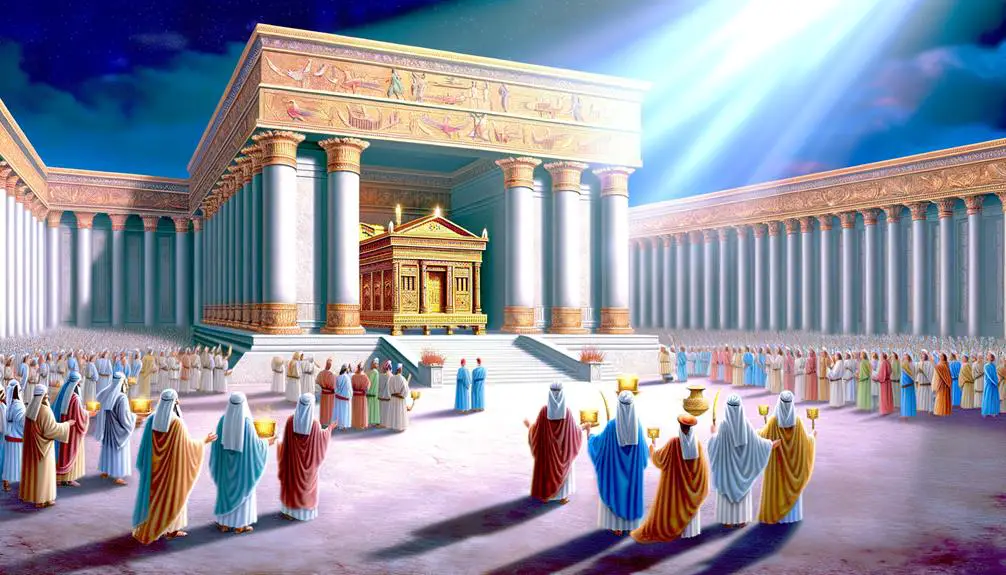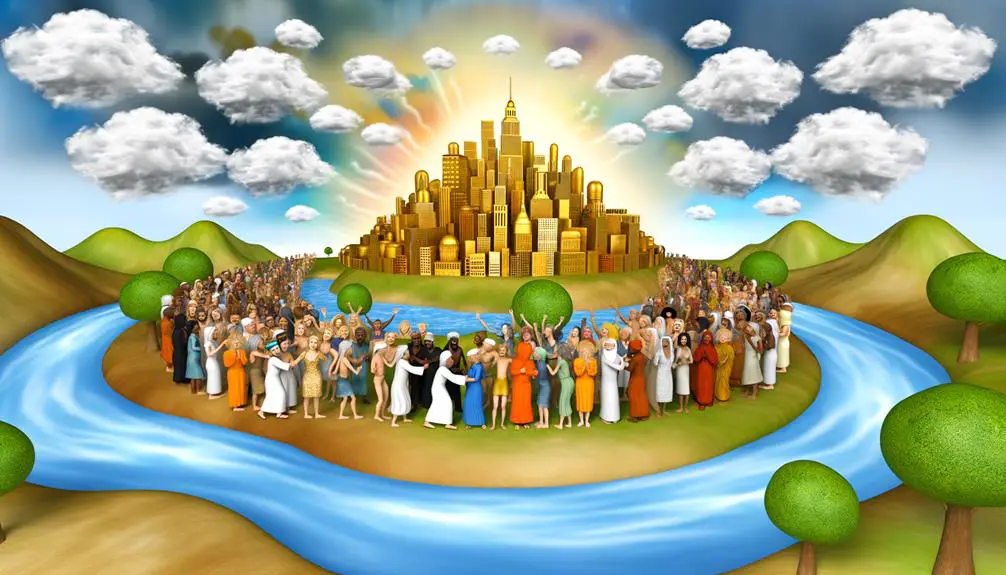Home in the Bible explores the journey from Eden to New Jerusalem, revealing the heart of belonging and faith's role in finding our place.

Home in the Bible
Home is where the heart is, and this adage finds deep resonance when you explore the concept of 'home' in the Bible. From the lush beginnings in the Garden of Eden to the ultimate promise of the New Jerusalem, the Bible's narrative weaves a rich tapestry of physical and spiritual dwellings that reflect humanity's quest for a place to belong. Each biblical home serves as a milestone in this journey, embodying lessons of faith, exile, and redemption.
By understanding these dwellings, you'll uncover layers of meaning that could transform your perception of what it truly means to be 'at home'. Curiosity piqued? Let's explore further.
Key Takeaways
- The concept of home in the Bible evolves from the Garden of Eden to the celestial New Jerusalem, symbolizing a journey from fall to redemption.
- Divine presence, manifested in the Tabernacle and Temple, redefines home as a space of worship and divine-human relationship.
- The New Jerusalem represents the ultimate homecoming, offering hope and eternal peace for believers beyond earthly confines.
- Home in the biblical narrative embodies spiritual fulfillment, collective identity centered on worship, and the realization of divine promises.
The Garden of Eden: Humanity's First

The Garden of Eden, often depicted as humanity's first abode, serves as a pivotal symbol in various theological discourses, embodying themes of innocence, fall, and redemption. You'll find that this narrative isn't just an ancient story but a foundational event that shapes the core of human understanding in religious contexts. The concept of original sin, central to this discourse, emerges directly from the Eden narrative, illustrating the profound consequences of Adam and Eve's actions.
Diving deeper, you encounter the Serpent's deception, a critical moment that sets the stage for the fall. This isn't merely about a snake and an apple; it's a complex examination of temptation, free will, and the loss of innocence. The serpent, often interpreted as a manifestation of evil or as Satan himself, beguiles Eve into disobeying God's explicit command not to eat from the Tree of Knowledge. This act of disobedience, fueled by the serpent's cunning persuasion, marks the inception of original sin, altering humanity's trajectory.
Analyzing this further, you realize that the Garden of Eden story doesn't just recount the fall but also frames the human condition in a context of moral and spiritual choice. The serpent's deception is pivotal, highlighting the vulnerability and responsibility of human agency. This narrative, rich in symbolism and theological significance, sets a precedent for the themes of sin and redemption that resonate throughout biblical literature.
In essence, the Garden of Eden story, with its complex layers of meaning, offers you a lens through which to explore fundamental theological concepts. It's a narrative that continues to influence and challenge our understanding of morality, free will, and divine justice.
The Exodus: Journeying Towards Promise

Following the narrative of humanity's earliest days in the Garden of Eden, we now embark on an equally monumental journey with the Exodus, a pivotal movement that not only reshaped the identity of a nation but also deeply influenced theological concepts of freedom, faith, and divine promise. The Exodus story is a complex tapestry of events, including the miraculous, the mundane, and the profoundly human struggle for liberation and identity.
Central to this narrative are the plague narratives, where divine intervention is vividly depicted. These plagues aren't merely acts of retribution but are deeply symbolic, representing the struggle between the divine and the earthly powers, and highlighting the inevitability of freedom promised by God. Furthermore, the theme of desert survival is paramount, showcasing not just a physical journey through a barren landscape, but also a spiritual odyssey towards faith and reliance on divine provision.
Key aspects of the Exodus include:
- Plague narratives: Demonstrating divine power and the liberation from bondage.
- Desert survival: A test of faith, endurance, and trust in divine promises.
- Divine guidance: Manifested through the pillar of cloud and fire, guiding the Israelites.
- Manna from heaven: Symbolizing divine sustenance in times of scarcity.
- Water from the rock: An emblem of divine provision in desperate times.
This journey from bondage to freedom, underpinned by divine intervention, not only redefined the concept of home for the Israelites but also established a foundational narrative for understanding divine-human relationships and the nature of faith, freedom, and divine fidelity.
The Tabernacle: God Amongst His People

Amidst the barren desert landscape, it became evident that the construction of the Tabernacle wasn't just an architectural feat but a profound manifestation of God's presence among His people. This portable sanctuary served not only as a focal point for worship but as a palpable sign of the divine dwelling amidst the Israelite community. The intricate details of its design and construction, as laid out in the biblical texts, underscore its role as sacred architecture, embodying theological principles and facilitating a unique form of worship.
The Tabernacle's structure, with its carefully prescribed dimensions and materials, mirrored the cosmos, symbolizing order in the midst of wilderness chaos. It was a microcosm of the world, designed to reflect heavenly realities on earth. This alignment between the physical and spiritual realms was further accentuated through the priestly garments, which weren't mere clothing but symbolic representations of holiness and divine service. These garments set the priests apart, visually reinforcing their roles as intermediaries between God and His people.
The meticulous design of the Tabernacle and the specific attire of the priests underscored the sanctity of the space and the solemnity of the rituals performed within. Through this sacred architecture and the vestments of its ministers, the Tabernacle served as a constant reminder of God's covenant, His laws, and His desire to dwell among His people. Thus, the Tabernacle was more than a dwelling; it was a tangible expression of God's ongoing relationship with His chosen people, a testament to His presence and guidance during their sojourn in the desert.
The Temple: A Fixed Place for Worship

As we move from the portable Tabernacle to the establishment of the Temple, you'll notice a significant shift in how worship was conducted, marking a pivotal moment in the spiritual and communal life of the Israelites. This transition to a fixed place of worship, the Temple, wasn't just a change in location but a profound evolution in the concept of sacred spaces and their role in connecting the divine with the earthly realm.
The Temple's architectural symbolism was rich and multifaceted, representing a microcosm of the universe and reflecting the Israelites' understanding of their relationship with God. It served not only as a physical space for worship but also as a profound statement about the nature of divine-human interaction. Here are some key aspects to consider:
- The meticulous design reflected a heavenly pattern, emphasizing that worship wasn't arbitrary but divinely orchestrated.
- The division into the Holy Place and the Most Holy Place underscored themes of holiness and accessibility to God.
- The use of specific materials and items, like gold and the Ark of the Covenant, highlighted the sacredness of the space.
- The Temple's orientation and the rituals performed within it were loaded with symbolic meaning, emphasizing a cosmic order.
- The presence of the Temple in Jerusalem made the city a religious epicenter, centralizing worship and reinforcing communal identity.
Understanding the Temple in this context reveals how sacred spaces function as intersections between the divine and the mundane, shaping religious practice and communal life. The architectural and symbolic nuances of the Temple underscore its significance as not merely a building, but a pivotal element in the spiritual landscape of the Israelites.
The New Jerusalem: Eternal Homecoming

Envisioned as the ultimate destination for believers, the New Jerusalem represents not merely a future hope, but a profound theological promise of eternal homecoming in the biblical narrative. This celestial city, as depicted in the scriptures, transcends our earthly understanding of home by offering a glimpse into a divine architectural masterpiece with city foundations that aren't just physical structures, but also symbolic of the eternal stability and security afforded to its heavenly dwellers.
The New Jerusalem's description, particularly its foundations adorned with precious stones, serves as a metaphor for the unshakeable faith and eternal heritage of those who find their ultimate rest within its walls. This city, therefore, isn't just a physical locality but a profound representation of spiritual fulfillment and the culmination of a redemptive history where God dwells among His people, eradicating every form of sorrow and death.
Moreover, the characterization of its inhabitants—referred to as heavenly dwellers—highlights a select community bound not by race or nationality, but by their shared faith and salvation history. These residents signify the fulfillment of divine promises and the realization of a spiritual kinship that transcends earthly divisions, embodying a collective identity centered around worship and service to God.
The New Jerusalem, then, stands as a theological anchor within the biblical narrative, offering both a vision and a promise of an eternal homecoming where the faithful are invited to partake in the divine presence, free from the temporal confines of earthly dwellings. In this celestial city, the concept of home is reimagined and fulfilled in its most profound and eternal form.
Frequently Asked Questions
How Do Biblical Teachings Influence Modern Christian Views on the Importance of Physical Homes Versus Spiritual Dwellings?
You'll find that biblical teachings deeply influence modern Christian perspectives on balancing the value of physical homes with spiritual dwellings.
This is rooted in the idea that life's a spiritual journey towards heavenly citizenship, emphasizing that while physical homes provide temporal shelter, true fulfillment comes from nurturing one's spiritual home.
This perspective encourages Christians to prioritize their spiritual development, viewing physical spaces as secondary to their eternal spiritual destination.
In What Ways Do Biblical Narratives About Home Challenge or Reinforce Traditional Family Structures and Roles?
When exploring how narratives shape perceptions, you'll find that gender dynamics and marital fidelity are pivotal. Consider that 50% of societies still adhere to traditional family roles, highlighting the influence of foundational stories.
Biblical accounts, without explicitly stating, challenge and reinforce these norms by depicting complex relationships and responsibilities within families. Analyzing these stories, you'll notice an intricate balance, challenging you to rethink traditional views on family structures and roles.
Can the Concept of "Home" in the Bible Be Related to the Idea of Community and Belonging Beyond the Physical Structures, and if So, How?
Yes, the concept of 'home' can indeed extend beyond physical structures to encompass ideas of community and belonging.
You'll find that in discussions on this topic, 'home' often symbolizes a sense of heavenly citizenship and the creation of sacred spaces within a community.
These notions challenge you to see 'home' not just as a place, but as a feeling of belonging and spiritual connection within a broader communal setting.
How Do Biblical Descriptions of Home Reflect or Contrast With Contemporary Societal Issues Such as Homelessness and Migration?
As you delve into this topic, remember 'home is where the heart is' takes on profound meaning.
Biblical concepts of home, reflecting on economic disparity and cultural assimilation, offer a mirror to contemporary issues like homelessness and migration.
These narratives not only highlight the spiritual over the physical but also challenge us to rethink our societal structures.
They urge a deeper understanding and response to the crises of belonging and community in today's world.
What Role Does Hospitality Play in the Biblical Understanding of Home, and How Is It Exemplified in Various Stories Throughout the Bible?
In exploring hospitality's role, you'll find it's central to understanding home, transcending mere physical spaces.
Through guest welcoming and feast preparations, the Bible showcases hospitality as a divine mandate.
It's exemplified in stories where individuals go beyond societal norms to honor guests, reflecting a broader, more inclusive notion of community.
Analyzing these narratives, you'll see hospitality as a powerful tool for building relationships and fostering unity, embodying a key biblical principle.
Conclusion
In analyzing the concept of 'home' within the biblical narrative, we've journeyed from the garden where humanity began, through the wilderness, towards places of divine presence and eternal promise.
Consider the story of Ruth and Naomi, a poignant tale of returning home that encapsulates themes of loyalty, redemption, and divine providence. This narrative arc, from Eden to the New Jerusalem, reflects a profound theological evolution: home isn't merely a physical space but a divine promise of belonging and restoration.


Sign up